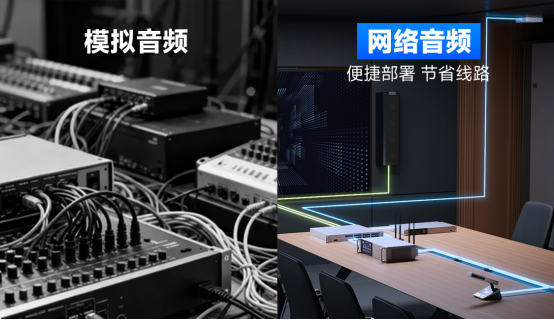Superior Sound, High Usability, and Strong Security: Hikvision Unveils an All-Encompassing Networked Audio System
![]() 11/07 2025
11/07 2025
![]() 513
513
Can you fathom a scenario? In today's world, where digital and network technologies are revolutionizing every corner of the globe, meeting audio and sound reinforcement systems still predominantly rely on analog signal technology. However, this audio technology, which emerged in the last century, is now grappling with a 'triple quandary':
Firstly, signals are vulnerable to exposure. Analog systems transmit signals via analog waves, emitting electromagnetic waves outward like antennas. These electromagnetic waves are 'exposed' in the air, making signals highly susceptible to interception. Consequently, with professional equipment, it's feasible to conduct contactless, long-distance 'eavesdropping'.
Secondly, physical intrusion poses no obstacle. The transmission pathways of analog systems are relatively fixed, and the transmitted analog signals, along with standardized physical interfaces, are neither encrypted nor coded. This enables direct reading or input of sound through physical contact with the lines.
Thirdly, anti-interference capabilities are feeble. Electromagnetic waves generated by ubiquitous electronic devices create electromagnetic noise/crosstalk signals that directly overlay onto the original waveforms of analog audio signals, causing sound interference. Moreover, during long-distance cable transmission, analog signals may suffer from quality degradation due to a decrease in the signal-to-noise ratio. Issues such as line aging and current loops formed by ground potential differences in multi-device interconnections further exacerbate system instability.
These shortcomings of analog systems can easily lead to sound information security breaches, triggering alarms across various industries. How can we better safeguard sound information security and ensure a superior sound quality experience?

Drawing on its extensive expertise in digital products and technologies, Hikvision has recently introduced a comprehensive networked audio system. Compared to analog systems, this audio system offers enhanced security, superior sound quality, and greater ease of use.
Enhanced Security: Encrypted Communication Thwarts Eavesdropping, Multi-Factor Authentication Prevents Intrusion
The networked audio system converts sound into digital signals and employs multi-layer encryption protection. Throughout the transmission process, from audio acquisition at the pickup end to audio playback at the sound reinforcement end, data packets remain encrypted. Even if the signal is intercepted, attackers will only obtain encrypted data that appears as gibberish and cannot be directly deciphered.
Furthermore, Hikvision's networked audio system integrates a range of network security technologies, including user identity authentication, access control lists (ACLs), and encrypted data transmission (e.g., TLS/SSL). Device access necessitates identity verification to ensure that only authorized users can access and control audio content.
In contrast to the transparent transmission of analog systems, which lack inherent encryption mechanisms, Hikvision's networked audio system provides end-to-center and hardware-to-software security across the board, creating a 'secure sound barrier'.

Superior Sound Quality: Network Transmission Resists Interference, AI Enhances Quality
From the core of signals, analog audio systems transmit analog electrical signals that are highly susceptible to external electromagnetic interference. In contrast, networked audio systems transmit digital signals that are inherently resistant to interference. During transmission, the content is encoded into binary data packets. As long as the receiving end can accurately identify the data logic, the sound can be fully restored without distortion. Even if subjected to certain interference, error detection and retransmission mechanisms built into networked audio output devices (such as network speakers) can correct and retransmit erroneous or lost data, ensuring uninterrupted and stable audio playback.
Additionally, Hikvision's networked audio system boasts intelligent algorithm capabilities throughout the entire chain, from sound acquisition and processing to playback. Through AI-driven intelligent noise reduction, AI-based dereverberation, and array and constant-width beamforming technologies, speech clarity in complex environments is enhanced, timbre is restored, and sound quality stability is ensured. Compared to analog audio systems, networked audio systems can better leverage innovative technologies such as AI algorithms, ensuring superior sound quality and an optimized audio experience.

Greater Ease of Use: Network Architecture Facilitates Scalability, Operational Status is Visualized
Leveraging the inherent advantages of IP network architecture, Hikvision's networked audio system enhances convenience and flexibility throughout the entire process, from deployment and management to expansion. Through Hikvision's self-developed audio software assistant, centralized and visualized management of the entire system is achieved, enabling remote monitoring of device status and management of device operations. This eliminates the need for repeated on-site inspections and 'blind box' checks associated with analog systems.
Furthermore, networked audio supports a wealth of functional expansions and system scalability. When integrating new devices, only routing configurations are required, eliminating the need for additional wiring or hardware matrix access. This truly enables 'on-demand modifications and expansions as needed.' For instance, in a 100㎡ conference room, replacing traditional solutions with Hikvision's networked audio solution can reduce wire usage by approximately 70% and increase deployment efficiency by 55%.

Security is often not an afterthought but a fundamental capability in scenarios such as meeting communications. Only by prioritizing sound information security and constructing a comprehensive security system encompassing technical protections and management norms can every meeting be conducted with confidence and every broadcast be transmitted reliably.
Based on digital, networked, and intelligent technologies, Hikvision's networked audio system integrates security capabilities and audio algorithms into its architecture. This not only achieves a leap from 'passive protection' to 'active defense' but also ensures more stable and superior audio quality. This not only addresses multiple pain points of the analog era but also lays the groundwork for future intelligent audio applications.








